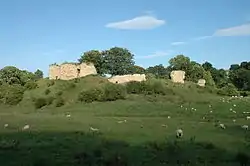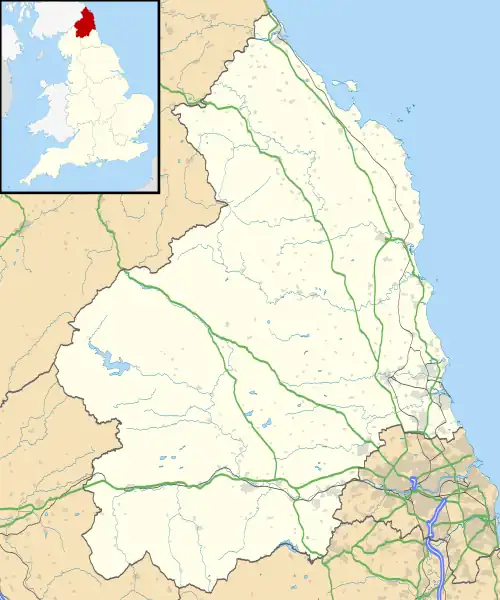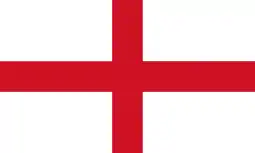| Mitford Castle | |
|---|---|
| Northumberland, England, UK | |
 Mitford Castle, 2005 | |
 Mitford Castle Location in Northumberland | |
| Coordinates | 55°09′50″N 1°44′02″W / 55.164°N 1.734°W |
| Grid reference | NZ170855 |
Mitford Castle is an English castle dating from the end of the 11th century and located at Mitford, Northumberland. It is a Scheduled Ancient Monument and a Grade I listed building, enlisted on 20 October 1969.[1] The castle is also officially on the Buildings at Risk Register. The Norman motte and bailey castle stands on a small prominence, a somewhat elliptical mound,[2] above the River Wansbeck. The selected building site allowed for the natural hill to be scarped and ditched, producing the motte.[1]
Mitford Castle was the first of three seats for the main line of the Mitford family constructed on manor lands. Following the destruction of Mitford Castle, Mitford Old Manor House (nearby and to the northwest) was used from the 16th century until the construction of Mitford Hall in 1828. Mitford Hall stands in an 85-acre (340,000 m2) park to the west of the castle ruins.
History
Prior to the 1066 Norman Conquest, the castle was held by Sir John de Mitford, whose only daughter and heiress, Sybilla Mitford, was given in marriage by William the Conqueror to the Norman knight, Richard Bertram.[3] In the late 11th century, it was an earthwork fortress of the Bertram family, and of record as William Bertram's oppidum in 1138. In 1215, it was seized by the English King John's troops.[1] In 1264, the castle was held by the third Roger Bertram, but in that year, it was seized from him and committed to the custody of William de Valence, 1st Earl of Pembroke, King Henry's half-brother.[2] It was held by Alexander de Balliol, the son of John de Balliol and the elder brother of John Balliol, King of Scotland (nicknamed 'Toom Tabard', meaning 'empty coat'), in 1275. During the rebellion in Northumberland in the 1310s, Mitford Castle was seized from the Valence family by Sir Gilbert de Middleton and Sir John de Lilburn.[2] In 1315, Mitford Castle was used by Sir Gilbert for kidnappings and as a gaol for high-profile prisoners such as Lewis de Beaumont, Bishop of Durham, his brother Harry de Beaumont and two Italian cardinals who had been travelling with him from Darlington to Durham. However, Ralph de Greystoke seized de Middleton for treason, and he was taken to the Tower of London and executed.[4]
There are conflicting accounts over the castle's destruction. One theory is of a fire during Middleton's rebellion. Another theory is that it was destroyed by the Scots in May 1318 during Middleton's imprisonment in the Tower of London. It was certainly destroyed by 1323 as records of an inquest held that year after the death of its then owner Aymer de Valence, Earl of Pembroke, state Mitford Castle to be " entirely destroyed and burnt."[2] At the time of his death in 1335, Mitford Castle had been seized from its then holder, David II Strathbogie, Earl of Atholl, 2nd baron.[5]
The estate, including the castle, was purchased by the Bruce Shepherd family in 1993 from the Mitford family.[6] English Heritage grants in the 2000s were offered towards repairs, restoration and preservation, and some of the work has been completed.[6][7]
Architecture

The castle ruins are ashlar quality squared stone construction. The inner ward was built in the early 12th century. The western section of the inner ward is on a stepped plinth and includes a large rounded archway. The eastern section of the inner ward wall has a rounded round arch to the outer ward of 19th-century reconstruction. The inner ward contains an unusual pentagonal keep that stands to the first floor and dates from the early 13th century. The keep was built on the highest point at the northernmost area of the castle with each of its five sides being of a different dimension,[2] and its internal area measuring approximately 22 sq ft (2.0 m2). The triangular outer ward to the south and east was built in the late 12th century. The divided basement contains two barrel-vaulted chambers that may have been used as cisterns.[1]
The chapel, built in the mid 12th century and largely destroyed in the early 19th century, is also of squared stone. A sanctuary or chancel arch remain.[8] A cemetery was uncovered in 1939 north of the chapel with headstones dating to the 12th century. At least one stone was moved to the Mitford churchyard with others removed or vandalised.[9]
Remains of a 12–13th century east curtain wall of squared stone include a gateway to a barmkin, mural chambers, garderobe, and a round arch.[10] This east curtain wall area is flanked by a semicircular breastwork; the strongest part of the building.[2] The west curtain wall and structures are also of the 12–13th century and squared stone, with different builds and masonry types found across three different sections.[11]
An inner courtyard used as a garden and orchard measured approximately 340 ft (100 m) by 340 ft (100 m).[2]
Notes
- 1 2 3 4 "Mitford Castle, Remains of Inner Ward and Keep, Mitford". britishlistedbuildings.co.uk. Retrieved 6 September 2010.
- 1 2 3 4 5 6 7 The Saturday magazine. Vol. 10. J. W. Parker. 1837. p. 50.
- ↑ Burke, Sir Bernard (1866). A genealogical history of the dormant, abeyant, forfeited, and extinct peerages of the British empire. Harrison. p. 52.
a genealogical history bertram barons bertram mitford.
- ↑ Burke (1866), pp. 254
- ↑ Burke (1866), pp. 517
- 1 2 "Historical Note". shepherdoffshore.com. Archived from the original on 3 December 2008. Retrieved 6 September 2010.
- ↑ "Mitford Castle, Mitford, Northumberland". english-heritage.org.uk. Archived from the original on 24 December 2012. Retrieved 6 September 2010.
- ↑ "Mitford Castle. Remains of Chapel in Outer Ward, Mitford". britishlistedbuildings.co.uk. Retrieved 6 September 2010.
- ↑ "Mitford Castle. Two Headstones to North of Chapel Ruin, Mitford". britishlistedbuildings.co.uk. Retrieved 6 September 2010.
- ↑ "Mitford Castle. Remains of East Curtain Wall, Mitford". britishlistedbuildings.co.uk. Retrieved 6 September 2010.
- ↑ "Mitford Castle. Remains of West Curtain Wall Buildings, Mitford". britishlistedbuildings.co.uk. Retrieved 6 September 2010.
References
- Somerset, F. P. (1980). The David & Charles Book of Castles. Newton Abbot, Devon: David & Charles. ISBN 0-7153-7976-3
External links
- Images of Mitford Castle
- Mysteries of Mitford Castle
- Historic England. "(inner ward and keep) (1370755)". National Heritage List for England.
- Historic England. "(west curtain wall buildings) (1042645)". National Heritage List for England.
- Historic England. "(east curtain wall) (1042646)". National Heritage List for England.
- Historic England. "(chapel) (1370756)". National Heritage List for England.
- Historic England. "(headstones) (1042647)". National Heritage List for England.
- Heritage at Risk Register: Mitford+Castle
